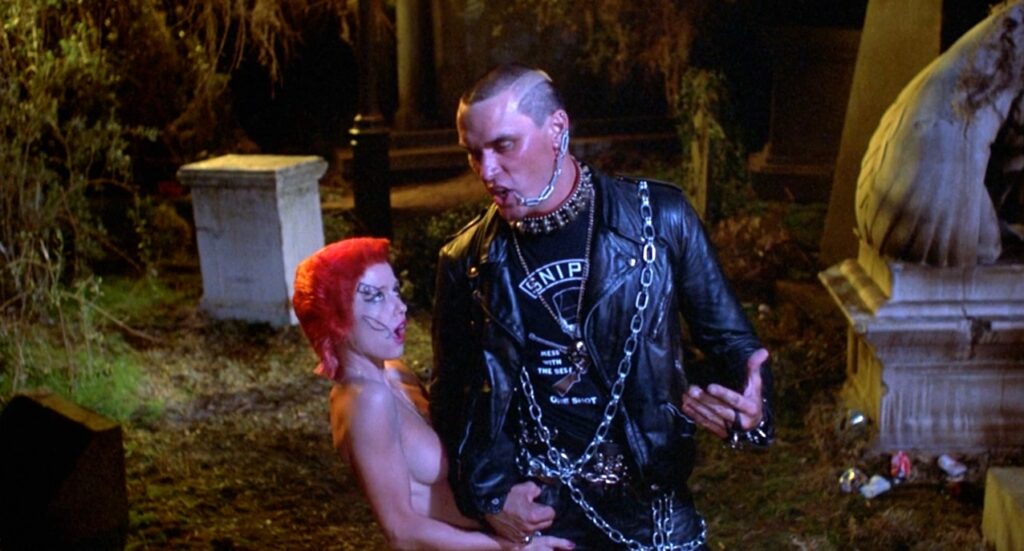
Borne out of a legal dispute between the original filmmakers behind Night Of The Living Dead (1968), The Return Of The Living Dead (1985) manages to be a remarkably cohesive synthesis of comedy and gross-out horror. Produced and conceived by John A. Russo and directed by special effects wizard Dan O’Bannon, The Return Of The Dead is the equal to George A. Romero’s own follow-up to Night Of The Living Dead, Dawn Of The Dead (1978). The split between Romero and Russo resulted in a unique dichotomy within the Zombie sub-genre of horror in which both Dawn Of The Dead and The Return Of The Living Dead address the same fundamental themes but in strikingly different ways.
The combined vision of Russo and O’Bannon looks to ground the innate human fear of its own mortality within a context closer to the B-movies of the sixties. Campy performances and slapstick moments create levity around disturbing sequences of more than just the prerequisite blood and guts spectacle. At the heart of The Return Of The Living Dead is this notion that, when exposed to a fictitious highly classified government developed chemical a human being can remain conscious as the body dies and continues to decay. The true terror of The Return Of The Living Dead is the idea that being dead literally hurts and it is this pain that motivates the zombie horde.
The Return Of The Living Dead opens with the character Frank (James Karen) telling Freddy (Thom Mathews) a yarn about a government cover-up of zombies that places the earlier film Night Of The Living Dead within the world of The Return Of The Living Dead as just another horror movie. In one swoop Russo establishes his film, The Return Of The Living Dead, as a reflexive commentary on Night Of The Living Dead rather than as a sequel to that film. As The Return Of The Living Dead proceeds, Russo continuously re-writes the laws regarding zombies that were established in his collaboration with Romero that the latter continued to apply to his own films in the genre.
The plot of The Return Of The Living Dead begins when Frank and Freddy inadvertently release the “zombie toxin” from a container that inevitably turns themselves into zombies just as it re-animates those buried in a nearby cemetery. Unbeknownst to them, a bunch of Freddy’s punk friends (including scream queen Linnea Quigley) are partying in that very graveyard. It isn’t long before their boss Burt (Clu Gulager), Freddy’s punk pals, and Ernie the mortician (Don Calfa) are fighting for their lives as the zombies lay siege to Ernie’s mortuary crying out for “more brains” and “more cops” to eat.
O’Bannon cross-cuts between the different narratives, tracking all of the characters until they come together into two besieged groups. The tension is palpable and the suspense expertly crafted. But O’Bannon’s real strength is in creating set pieces around the gooey re-animated corpses. Some, such as the female corpse the main characters interrogate, are puppets while most are just extras bathed in mud and make-up. In true B-movie fashion the bulk of the action is set at night during a rainstorm that disguises any faults in these effects. Unlike Romero’s zombies, the undead in The Return Of The Living Dead are wet with rot, practically collapsing in on themselves with advanced decay.
Driving this cult classic along is a remarkable soundtrack that features original music by Matt Clifford and Francis Haines as well as songs by The Cramps, The Damned and Rocky Erickson. While this aspect of the film is true to many of the characters, The Return Of The Living Dead is, on an aesthetic level, just as concerned with placing itself within the broader context of its genre. It is to this end that Linnea Quigley is given one of her most memorable characters (Trash) as well as her most infamous scene. Sexploitation and horror have always been intermingled but never more so than when Quigley inexplicably begins to dance and strip in the middle of a graveyard. For the rest of the film she remains mostly naked, epitomizing the 80s scream queen persona to the max.
The expansive intertextuality of The Return Of The Living Dead and its tongue-in-cheek seriousness is wholly successful to the point of being entirely unique. It’s a “must see” cult classic that actually lives up to its reputation in a way that few films of this ilk actually do. The Return Of The Living Dead is quintessentially 80s and totally unlikely but a masterpiece nonetheless.
